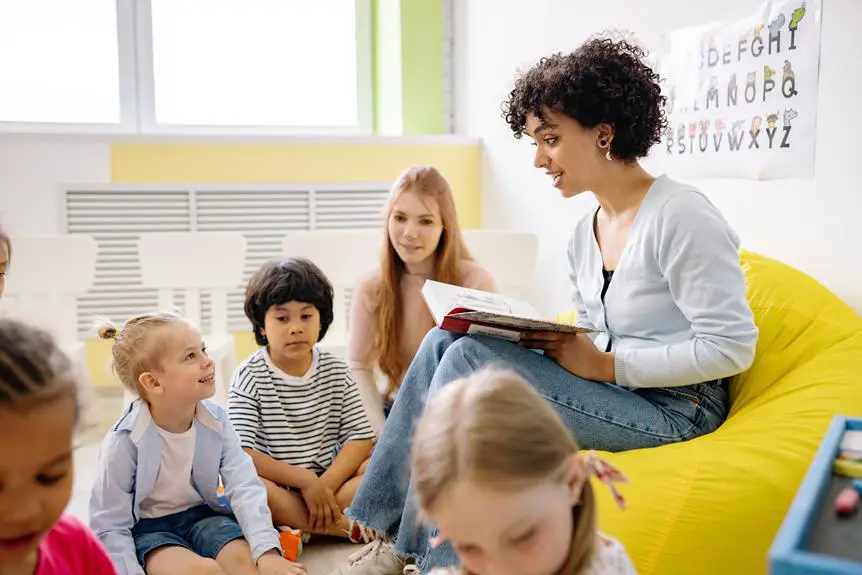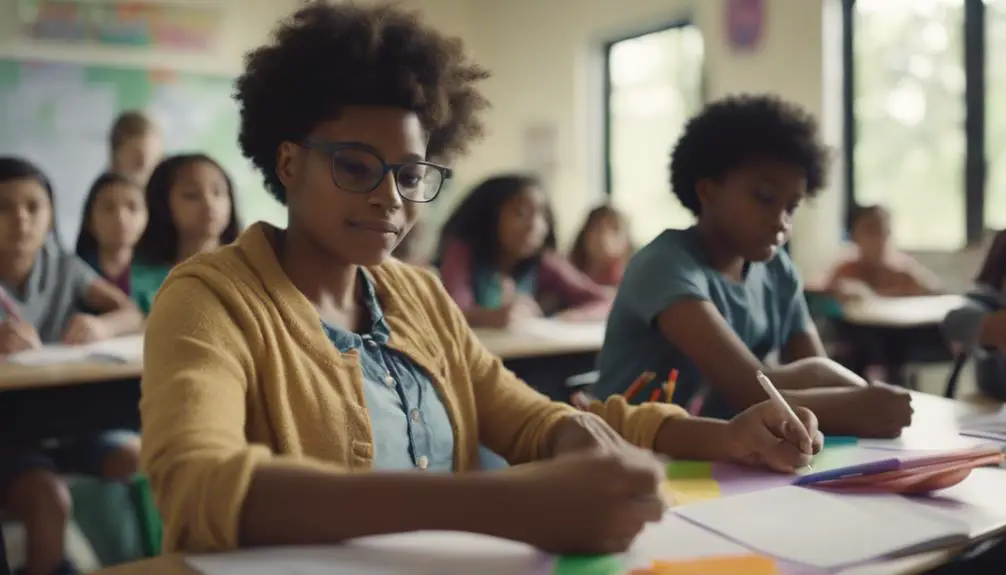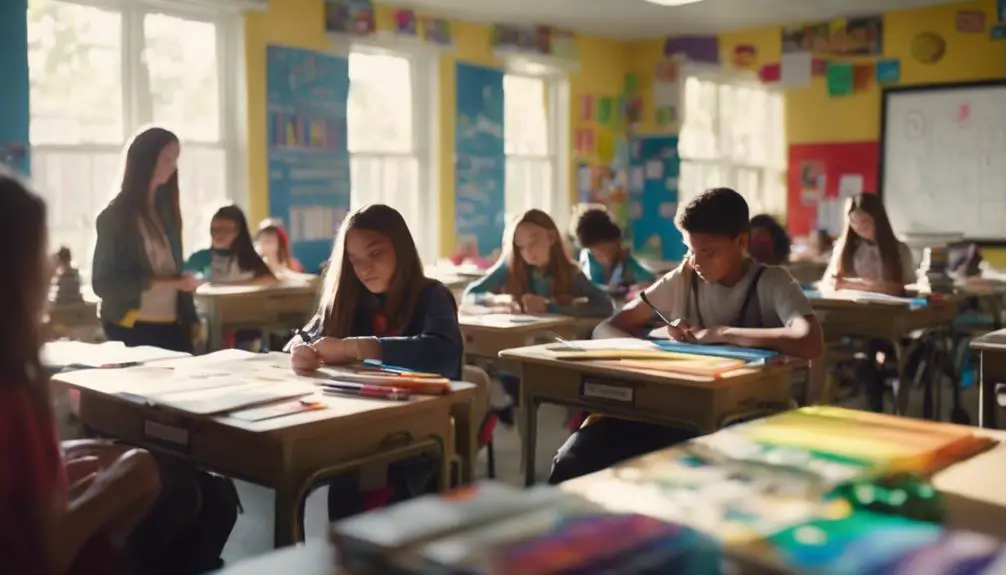A dysregulated child in the classroom can create a disruptive atmosphere for educators and classmates. As teachers, it’s important for us to know how to calm these children and guide them towards a peaceful state.
But how do we achieve this balance? In this discussion, we will explore strategies and techniques to support dysregulated children in the classroom. From breathing exercises to collaboration with parents, we will uncover the secrets to creating a calm and nurturing environment for all students.
Let’s discover the ways we can empower and uplift these young minds together.
25 tips to calm a dysregulated child in your classroom
Calming a dysregulated child in the classroom requires implementing various strategies and steps.
Some effective techniques include:
- Practicing deep breathing exercises
- Providing sensory breaks
- Using visual schedules
- Creating quiet corners
- Using positive affirmations
Deep Breathing Exercises
To help calm a dysregulated child in the classroom, using deep breathing exercises can be an effective strategy. Deep breathing exercises can promote relaxation, reduce stress and anxiety, and improve focus and concentration. Here are four mindfulness techniques to try:
- Belly Breathing: Encourage the child to place one hand on their belly and take slow, deep breaths, feeling their belly rise and fall with each breath.
- Counting Breath: Have the child count their breaths, inhaling for a count of four, holding for a count of four, and exhaling for a count of four.
- Straw Breathing: Give the child a straw and ask them to take slow breaths in and out through the straw, focusing on the sensation of the breath.
- Balloon Breath: Instruct the child to imagine their belly is a balloon, slowly inflating with each inhale and deflating with each exhale.
Sensory Breaks
One effective strategy to calm a dysregulated child in the classroom is by using sensory breaks. Sensory breaks are short periods of time where a child can participate in activities that stimulate their senses and help regulate their emotions and behavior. These breaks can be incorporated into the classroom to create a calming environment and promote self-regulation.
During a sensory break, the child can participate in activities such as deep pressure exercises, fidget toys, or listening to calming music. It’s important to have a designated space for these breaks where the child feels safe and comfortable. By incorporating sensory breaks into the classroom routine, teachers can support the child’s self-regulation techniques and behavior management.
Some examples of sensory break activities and their benefits include:
- Deep pressure exercises: Calms the nervous system and reduces anxiety.
- Fidget toys: Helps redirect restless energy and improves focus.
- Calming music: Promotes relaxation and reduces stress.
- Visual Schedules
After incorporating sensory breaks into the classroom routine, another effective strategy to calm a dysregulated child is by using visual schedules. Visual schedules provide a clear and structured way for the child to understand and manage their time, develop organization skills, and improve task completion.
Here are four reasons why visual schedules can be beneficial in supporting a dysregulated child’s executive functioning:
- Time Management: Visual schedules help the child understand the concept of time and develop better time management skills by visually representing the order and duration of activities.
- Organization Skills: By breaking down tasks into smaller, manageable steps, visual schedules promote organization. This helps the child stay organized and focused on completing each task.
- Task Completion: The visual representation of tasks on the schedule provides a sense of accomplishment as the child checks off completed tasks. This boosts their motivation and self-esteem.
- Executive Functioning: Visual schedules improve executive functioning by promoting planning, organization, and self-regulation skills. They provide a predictable structure that helps the child feel more in control and reduces anxiety.
Quiet Corners
Implementing a designated quiet corner in the classroom can help calm a dysregulated child. Quiet corners provide a safe and calming space where a child can manage their emotions and regain control.
These corners can have mindfulness activities like breathing exercises or guided meditation to help the child focus and relax. Physical activities like stretching or using stress balls can release tension and promote self-soothing.
Social stories can also be placed in the quiet corner to show appropriate behavior and coping strategies. Transitional cues like soft lighting or calming music can enhance the calming environment.
Positive Affirmations
Using positive affirmations is an effective strategy for calming a dysregulated child in the classroom. Positive affirmations can help build self-esteem, promote positive self-talk, and develop emotional regulation and self-confidence in children.
Here are four ways to incorporate positive affirmations into your classroom routine:
- Start the day with affirmations: Begin each day by having the children recite positive affirmations like ‘I am capable,’ ‘I am loved,’ or ‘I can handle challenges.’
- Encourage self-affirmation: Teach children to create their own positive affirmations and remind them to use these affirmations when they feel dysregulated.
- Display affirmations: Hang posters with affirmations around the classroom as visual reminders for the children.
- Provide affirmation cards: Give each child affirmation cards they can keep with them and refer to whenever they need a boost of positivity.
Calming Music
To calm a dysregulated child in the classroom, playing calming music can be an effective strategy. Music therapy has been proven to positively impact emotional regulation and relaxation techniques.
Creating playlists with soothing melodies can help create a peaceful and calming environment for the child. The power of music for emotional regulation shouldn’t be underestimated. When a child is dysregulated, playing soft and gentle music can help them find calm and stability. It can aid in regulating breathing, lowering heart rate, and reducing anxiety.
Incorporating music into the classroom can be a simple yet powerful tool in supporting the emotional well-being of dysregulated children.
Mindfulness Activities
After introducing calming music to the classroom, the next step in helping a dysregulated child is to incorporate mindfulness activities. These activities assist children in focusing their attention, managing their emotions, and finding a sense of calm. Here are four effective mindfulness activities to consider:
- Mindful coloring: Provide coloring sheets and encourage children to color mindfully, paying close attention to the colors, shapes, and movements of their hands.
- Breathing exercises: Teach children simple breathing techniques, such as deep belly breathing or counting breaths. These techniques can help them relax and center themselves.
- Nature walks: Take the class outside for a walk in nature, encouraging children to observe and appreciate the sights, sounds, and smells of the natural world around them.
- Yoga poses: Guide children through simple yoga poses that promote body awareness, balance, and relaxation.
Incorporating these mindfulness activities into the classroom can greatly benefit dysregulated children by providing them with tools to find calm and regulate their emotions.
Physical Activities
Incorporating physical activities into the classroom can help calm a dysregulated child. Active games, outdoor exercises, sports activities, play therapy, and movement breaks are effective strategies for regulating a child’s emotions and behavior.
Engaging in active games like Simon Says or dancing to music can redirect a dysregulated child’s focus and release pent-up energy.
Outdoor exercises such as running or playing tag allow children to expend their energy in a positive and controlled manner.
Sports activities like basketball or soccer encourage teamwork and provide an outlet for physical exertion.
Play therapy, through activities like building with blocks or creating art, helps children express themselves and process their emotions.
Including movement breaks throughout the day, where children can stretch or do simple exercises, can also help them refocus and calm down.
Social Stories
When using physical activities in the classroom to help a dysregulated child calm down, another effective method is to use social stories.
Social stories are short narratives that provide children with guidance on appropriate social skills, emotional regulation, and behavior management. They can be especially helpful for children with autism or other developmental disabilities who’ve difficulty understanding and expressing their emotions.
Social stories teach children how to communicate their needs and feelings in a way that’s socially acceptable, giving them a framework for handling challenging situations. By reading and discussing social stories together, educators can support the child’s learning and reinforce positive behaviors.
This communication strategy promotes a safe and inclusive classroom environment where all children can thrive and succeed.
Transitional Cues
To help a dysregulated child in the classroom, I often use cues to create structure and support. These cues are crucial in managing transitions and guiding children from one activity to another. They can be visual, like a timer or a chime, or auditory, signaling the end of one task and the start of another.
By integrating calming techniques into transition routines, we establish predictability and security for the child. This empowers them, reduces anxiety and frustration, and promotes self-regulation.
Smooth transitions are essential for maintaining a positive and productive learning environment, allowing the child to focus on their tasks and actively participate in classroom activities.
Self-Regulation Tools
I use a variety of tools to help calm dysregulated children in the classroom. Here are four effective techniques that I rely on:
- Mindfulness exercises: I encourage students to focus on the present moment, helping them become aware of their thoughts and emotions without judgment. This promotes a sense of calm and inner peace.
- Breathing techniques: Teaching deep breathing exercises allows children to regulate their emotions and reduce anxiety. By taking slow, deep breaths, they can activate their parasympathetic nervous system and promote relaxation.
- Sensory strategies: Engaging the senses can help redirect attention and promote self-regulation. For example, providing fidget tools or sensory objects can offer a calming outlet for restless energy.
- Emotional regulation and self-control techniques: I teach children strategies to identify and express their emotions in healthy ways. This includes using positive self-talk, practicing problem-solving skills, and engaging in activities that promote emotional well-being.
Empathy and Understanding
Using empathy and understanding, I create a safe and supportive environment to calm dysregulated children in the classroom. As an educator, I understand the importance of connecting with my students on an emotional level and validating their feelings. Here are some exercises and techniques that I employ to promote empathy and understanding:
- Perspective taking: By putting ourselves in the shoes of our students, we can better understand their experiences and emotions.
- Role-playing: This technique allows students to step into different perspectives and gain a deeper understanding of others’ feelings.
- Emotional mirroring: By reflecting and acknowledging the emotions of our students, we create a space where they feel heard and understood.
- Active listening: By truly listening to our students, we show them that their thoughts and feelings are valued.
- Reflective questioning: By asking open-ended questions, we encourage our students to reflect on their own emotions and experiences.
- Non-judgmental attitude: Creating an environment free from judgment allows students to express themselves honestly and feel accepted.
Clear and Consistent Expectations
Implementing clear and consistent expectations is crucial in effectively calming a dysregulated child in the classroom. When students understand what’s expected of them, it provides them with structure and security, which can help regulate their emotions.
Consistent routines and behavior management strategies also play a vital role in creating a calm and supportive environment. Here are four key elements to consider:
- Clear Classroom Rules: Clearly communicate and reinforce the classroom rules to ensure students understand the boundaries and expectations.
- Consistent Routines: Establish consistent routines for daily activities, transitions, and classroom procedures to promote predictability and stability.
- Behavior Management Techniques: Use effective behavior management techniques such as positive reinforcement, redirection, and consequences to address and modify disruptive behaviors.
- Student Accountability: Hold students accountable for their actions by regularly reviewing and discussing their behavior, providing feedback, and involving them in developing solutions.
Verbal De-Escalation Techniques
When working with a dysregulated child, it’s important to listen actively and approach them without judgment. By listening actively, we show the child that we genuinely care about their feelings and concerns. Approaching them without judgment creates a safe space for the child to express themselves without fear of criticism.
Using calm and soothing tones can help alleviate their distress. Teaching the child techniques to regulate their emotions empowers them to manage their emotions in a healthy way.
Lastly, building trust through consistent support and understanding fosters a positive relationship, which ultimately helps calm the dysregulated child.
Use Proximity Control and Physical Touch
Maintaining close proximity and offering gentle physical touch can be effective in calming a dysregulated child in the classroom.
Proximity control and physical touch are powerful tools for emotional regulation and behavior management in a classroom environment. Here are four ways in which these techniques can be effective:
- Create a sense of safety: Being physically close to a dysregulated child can provide a sense of security and reassurance, helping them feel safer and more grounded.
- Establish connection: Physical touch, such as a hand on the shoulder or a comforting hug, can help establish a connection with the child, showing them that they aren’t alone and that their feelings are valid.
- Provide regulation cues: Gentle touch can serve as a non-verbal cue for the child to regulate their emotions and behavior, signaling them to calm down and refocus.
- Foster trust and rapport: Through proximity control and physical touch, trust and rapport can be built, creating a supportive and nurturing classroom environment where the child feels understood and cared for.
Redirecting Attention
One effective way to help a dysregulated child calm down in the classroom is by redirecting their attention. When a child is feeling overwhelmed or agitated, redirecting their focus can assist them in regaining control and finding a calmer state.
Attention redirection techniques involve shifting their attention away from the source of distress and towards something more positive or engaging. This can be achieved by directing their focus towards a task or activity that captures their interest or by guiding their concentration towards a calming stimulus, such as deep breathing or a sensory object.
Offering Choices
I often calm a dysregulated child in the classroom by offering them choices. This strategy helps them regain a sense of control and empowers them to make decisions for themselves.
Here are four ways offering choices can be effective in promoting emotional regulation and behavior management:
- Provide options: Give the child a few alternatives to choose from, such as deciding where to sit or which activity to engage in. This allows them to feel heard and respected.
- Problem-solving techniques: Encourage the child to think critically and find solutions to their own challenges. By offering choices, you’re teaching them valuable problem-solving skills.
- Foster independence: Offering choices promotes independence and self-confidence. It helps the child develop decision-making abilities, leading to better emotional regulation.
- Classroom strategies: Incorporating choice-making into classroom routines and activities can create a positive and inclusive environment. It allows the child to feel valued and respected, contributing to their overall well-being.
Collaborative Problem-Solving
After giving choices to a dysregulated child in the classroom, another effective strategy to calm them is through working together to solve problems. By collaborating on problem-solving, we can help the child develop their communication strategies, techniques for managing their behavior, strategies for regulating their emotions, and skills for resolving conflicts. This approach allows the child to feel heard and valued, which creates a sense of empowerment and helps to foster a positive classroom environment. Through open and respectful discussions, we can address the underlying issues that may be causing the dysregulation and work together to find solutions. The table below demonstrates how collaborative problem-solving can benefit both the child and the classroom:
| Benefits of Collaborative Problem-Solving |
|---|
| Promotes active listening and empathy |
| Encourages problem-solving skills |
| Builds a sense of responsibility and accountability |
| Fosters positive relationships and trust |
| Supports the development of self-regulation strategies |
Seeking Additional Support
Seeking additional support is important when dealing with a dysregulated child in the classroom. It’s crucial to tap into extra resources and seek professional guidance to help the child regulate their emotions. Here are four ways to find additional support:
- Use additional resources: Access books, articles, and online materials that offer insights and strategies for supporting dysregulated children.
- Seek professional advice: Consult with school counselors, psychologists, or behavior specialists who can provide expert guidance tailored to the child’s specific needs.
- Consider specialized interventions: Explore options like occupational therapy, speech therapy, or social skills training to address underlying issues contributing to the child’s dysregulation.
- Implement individualized strategies: Collaborate with the child’s support team to develop personalized strategies that address their unique needs and preferences.
Practice Patience and Flexibility
To effectively calm a dysregulated child in the classroom, it’s important to practice patience and flexibility. Implementing strategies that prioritize their emotional regulation and well-being is crucial. As educators, we must recognize that each child is unique and may require personalized approaches to find what works best for them.
By incorporating mindful breathing exercises and flexible strategies into our daily routines, we can create a calm and supportive environment for our students. Patience and understanding are key in this process, as it may take time for a child to regain their composure.
Additionally, utilizing various calming techniques such as sensory tools, quiet corners, or relaxation exercises can provide a safe space for the child to self-regulate.
Collaborate with Parents
Collaborating with parents is important in effectively calming a dysregulated child in the classroom. By establishing a strong parent-teacher partnership, we can create a supportive environment that promotes the well-being of the child.
Here are four communication strategies to involve families and strengthen the home-school connection:
- Regular updates: Keep parents informed about their child’s progress, behavior, and any challenges they may be facing in the classroom. This open line of communication helps parents understand their child’s needs better.
- Parent-teacher conferences: Schedule regular conferences to discuss the child’s academic and emotional development. This allows for a deeper understanding of the child’s challenges and enables parents to provide valuable insights.
- Collaborative problem-solving: Involve parents in finding solutions to the child’s dysregulation. By working together, we can develop strategies that can be implemented both at home and in the classroom.
- Parent workshops: Organize workshops where parents can learn about techniques and strategies to support their child’s emotional regulation. This empowers parents to play an active role in their child’s well-being.
Through collaboration with parents, we can create a comprehensive approach to calming dysregulated children in the classroom and foster a nurturing learning environment.
Implement Peer Support Groups or Establish a Buddy System
Implementing peer support groups or establishing a buddy system can effectively calm a dysregulated child in the classroom. By creating a structured environment where students can support and help each other, we promote empathy, understanding, and a sense of community among the students.
Peer support groups allow dysregulated children to connect with their peers, who can be positive role models and provide emotional support. The buddy system pairs a dysregulated child with a peer who can offer guidance and assistance during challenging moments.
These strategies not only provide immediate support but also teach important social skills and promote a positive classroom culture. By implementing these interventions, we can create a supportive and inclusive environment that fosters student well-being.
Conclusion
Calmly addressing a dysregulated child in the classroom can be quite challenging. However, by being patient, understanding, and employing effective strategies, it’s possible to bring a sense of tranquility to their storm. Our approach should be like a gentle breeze that soothes turbulent waters, making a profound impact on these children. By helping them find their center amidst the chaos, we empower them to confidently navigate the school’s challenges with resilience.
To calm a dysregulated child, it’s important to use clear and straightforward language. Avoid using clichés or overused phrases, and instead, provide context to explain the significance of our actions. Transitions should flow naturally based on the situation, and using active voice will ensure clarity.
In order to better support these children, it may be helpful to provide specific examples and recommend appropriate products if necessary. Additionally, we should ensure that our writing is free from spelling and grammar errors, adopting a conversational style that mimics human writing. By creating comprehensive paragraphs with rich details, we can effectively address the needs of dysregulated children in the classroom.
Let’s now proceed to answer the question directly, without asking rhetorical questions or using unnecessary phrases.



















